隼鸟2号收集龙宫地表下物质
建安区三高 张志鹤
Japan's space agency says a Japanese spacecraft successfully landed on an asteroid Thursday and collected material from under its surface.
The Hyabusa2 spacecraft landed briefly inside a small crater on the asteroid Ryugu. The space agency reported that it rose safely from the surface after collecting dust and rock samples.
Space scientists hope that tests of the material will provide information about the formation of our solar system.
Officials with the Japanese Aerospace Exploration Agency, known as JAXA, excitedly announced the results. They said data confirmed that the spacecraft had landed on Ryugu and returned to a position above the surface.
After the operation was completed, everyone in the command center stood up and cheered.
It was a success, a big success, said Takashi Kubota, a project member. He added that the operation had been successful in all its planned activities.
In April, Hyabusa2 fired a two kilogram object into the surface, creating a crater on the asteroid. On Thursday, the spacecraft returned to the same area, where it landed for only a few seconds. The goal was to collect rock and dust samples from beneath the surface. The spacecraft shot a small object into the soil and used a tube to gather the material.

Getting to rocks and other material below the surface is important, scientists say, because it is unaffected by radiation from space and other influences.
JAXA said the samples have been safely placed in a container which will be moved to a capsule for safe storage.
The operation is the most important experiment yet by Hyabusa2. Its next project is to return safely to Earth with the soil samples.
Project manager Yuichi Tsuda said that an experiment like this has never been attempted before. Nobody has collected and brought home underground materials from anywhere further than the moon, he added.
The Hyabusa2 is the first spacecraft to collect samples from under the surface of an asteroid. The United States space agency NASA plans a similar mission to an asteroid called Bennu.
Hyabusa2 will continue to take pictures of Ryugu until it begins its 300 million kilometer trip back to Earth. It is expected to return home in late 2020.
日本宇航局表示,日本某航天器周四已成功着陆于一颗小行星上,并从这颗小行星表面收集了一些物质。
隼鸟2号宇宙飞船短暂停留在小行星龙宫上的一个小型陨坑处。日本宇航局表示,隼鸟2号收集了尘土和岩石样本后安全地从其表面飞离。
一些太空科学家希望,对所收集物质的检测能够提供信息,让我们了解太阳系组成的信息。
日本宇宙航空研究开发机构(JAXA)的几位工作人员激动地宣布了该结果。他们表示,数据已确认——隼鸟2号已着陆于龙宫,并返回了龙宫上方的一个位置。
此次任务结束后,指挥中心的每个人都站起来欢呼雀跃。
这是一次成功,一次巨大的成功,项目成员久保田隆如是说道。他补充表示,这次任务如期完成了所有计划中的活动。
4月,隼鸟2号从其表面发射了2公斤重的物体,在小行星上创造了一个陨坑。周四,隼鸟2号返回了该陨坑,并在那里停留了数秒。目的是收集地表下的岩石和尘土样本。隼鸟2号将一个小物体击入土壤之中,还通过试管收集了物质。
科学家表示,获得地表以下的岩石等物质意义重大,因为这部分的物质不会受到太空等外界的影响。
JAXA表示,样本可以安全地放在一个容器里,容器会挪到太空舱中进行安全保存。
这次任务是隼鸟2号执行的最重要的一次实验。其下一个项目是带着土壤样本安全返回地球。
项目经理人津田雄一表示,这样的实验以前是从未尝试过的。没有人收集并带回过月球之外任何地方的地下物质。
隼鸟2号是第一个从小行星表面收集样本的宇宙飞船。美国宇航局(NASA)计划对一颗名为贝努的小行星执行类似的任务。
隼鸟2号会继续拍摄龙宫的照片,然后会跋涉3亿公里返回地球。预计2020年晚些时候,隼鸟2号会回到地球。
